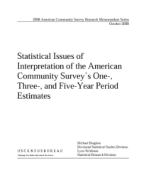Statistical Issues of Interpretation of the American Community Survey's One-, Three-, and Five-Year Period Estimates -- Expanded Version
Statistical Issues of Interpretation of the American Community Survey's One-, Three-, and Five-Year Period Estimates -- Expanded Version
The U.S. Census Bureau began implementation of the American Community Survey (ACS) at its full sample size in 2005. The ACS five-year estimates will be calculated for subject and geographic detail comparable to the U.S. Census Bureauâs former decennial long form, but produced annually. While the long form represented a snapshot in time, April 1, 2000, the ACS interviews monthly samples (U.S. Census Bureau, 2006a) that will ultimately produce three types of period estimates: one based on one year of collected data, one based on three years, and one based on five years. The three-year and five-year estimates are referred to as multiyear estimates (MYE). In 2006 the U.S. Census Bureau published one-year estimates based on data collected in 2005, and in 2007 one-year estimates based on data collected in 2006. In 2008 the U.S. Census Bureau will publish its first three-year estimates based on data collected from 2005 through 2007 in addition to the 2007 one-year estimate. In 2010 the U.S. Census Bureau will publish its first five-year estimates based on data collected from 2005 through 2009, in addition to producing one-year and three-year estimates. The U.S. Census Bureau expects that the five-year ACS estimates will be the default estimates to which users will first be directed. Thus a basic comprehension of the annual five-year MYEs is essential for all data users. But many users will also want to explore and understand the possibilities offered by the three-year and one-year estimates. While this paper aims at aiding all data users, it is more helpful to the latter.
Others in Series
Working Paper
Working Paper
Working Paper




